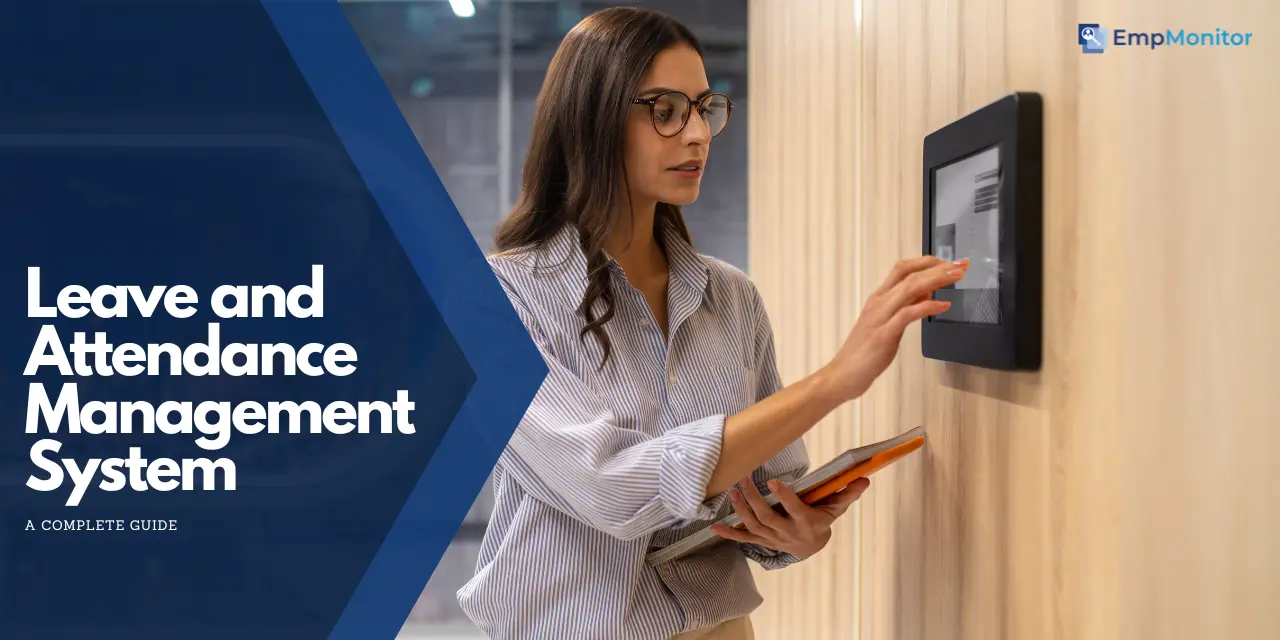Leave and attendance management often feels like an endless loop. Between keeping track of who’s off, handling last-minute changes, and balancing team needs, it’s easy for things to slip through the cracks. Whether you’re an employee hoping to request time off without hassle, or a manager trying to coordinate schedules and ensure productivity, the challenge is real.
A leave and attendance management system can make all of this much easier. It’s not just about tracking days off; it’s about creating a system that works for everyone. These systems fall under broader HR solutions —see how HR software pricing compares to choose what works best for your organization.
By automating processes, centralizing data, and keeping communication clear, such a system ensures that employees and managers can focus on their core tasks without worrying about who’s available or when someone can take leave.
This guide will show you how implementing a smart system can help you transform time management from a headache into a seamless, efficient process.
In a hurry? Listen to the blog instead!
What is a Leave and Attendance Management System?
A leave and attendance management system is a software platform built to streamline the tracking of employee attendance and the management of leave requests. It enables organizations to manage vacation days, sick leave, holidays, and other absences efficiently. By implementing this system, businesses can ensure accurate record-keeping, reduce administrative burdens, and enhance employee satisfaction.
In the traditional approach, managing leave and attendance often involved cumbersome paperwork and manual calculations. However, with technological advancements, these processes have been streamlined and automated. Modern systems now offer a centralized platform to allow employees and managers easy access to information related to attendance and leave.
Essential Features of a Leave and Attendance Management System –
Automated Leave Requests and Approvals
A key feature of attendance and leave management software is the automation of leave request submissions and approvals. Employees can submit leave requests through an easy-to-use interface, allowing managers to review and approve them electronically. This feature minimizes paperwork and speeds up the approval process, significantly reducing the time spent on administrative tasks.
Real-Time Attendance Tracking
With features like clock-in/clock-out capabilities, employers can monitor employee attendance in real time. This capability helps reduce discrepancies and ensures accountability.
Real-time tracking helps businesses identify attendance patterns and address issues quickly. For example, if a particular employee consistently arrives late, managers can intervene before it affects team performance.
Reporting and Analytics
The system provides insightful reports on attendance trends, leave patterns, and workforce productivity. These analytics help businesses make informed decisions and improve resource allocation.
By analyzing this data, organizations can identify areas for improvement, such as addressing high absenteeism in specific departments or understanding the impact of leave policies on overall productivity.
Many businesses are adopting solutions like EmpMonitor to improve their reporting capabilities. This powerful tool complements a leave and attendance management system by providing advanced analytics and reporting features.
Integration with Payroll Systems
A seamless integration with payroll systems ensures that attendance data directly impacts salary calculations, reducing errors and ensuring compliance with labor laws.
This integration eliminates the need for manual data entry, saving time and minimizing the risk of discrepancies in payroll processing. Employees can feel assured that their leave and attendance will not adversely affect their compensation.
Employee Self-Service Portal
Empowering employees with a self-service portal allows them to view their leave balances, apply for time off, and access their attendance records. It
fosters transparency and trust within the organization.
Employees appreciate having control over their leave management, leading to higher engagement and satisfaction. This self-service approach saves HR time and fosters a sense of responsibility among employees.
Mobile Accessibility
In an increasingly mobile workforce, having access to the leave and attendance management system via mobile devices is essential. This feature is particularly crucial for field force tracking, where employees may not always be at a desk or in the office. Again you can utilise the powers of EmpMonitor, which allows employees to request leave, check their attendance records, and clock in/out directly from their smartphones, ensuring they stay informed and engaged, even while on the go.
This flexibility enhances their work-life balance and guarantees accurate attendance tracking, regardless of location. It’s a necessity for businesses with mobile or field-based teams, helping maintain seamless operations and improving employee morale.
Customization Options
Every business has unique leave policies and attendance tracking requirements. A robust leave and attendance management system should offer customization options to fit these needs. It might include different leave types, approval workflows, and reporting formats that align with your organization’s practices.
Pros of a Leave and Attendance Management System
Improved Efficiency
Implementing a leave and attendance management system automates repetitive tasks, allowing HR personnel to focus on more strategic activities. Businesses can save time and reduce administrative costs by minimizing manual data entry and paperwork. This efficiency translates to smoother operations and improved overall productivity.
Enhanced Accuracy
Human errors in attendance tracking can lead to payroll discrepancies and employee dissatisfaction. A dedicated attendance and leave management system ensures accurate data recording, reducing the risk of errors and disputes. This accuracy fosters trust among employees, knowing that their leave requests and attendance are being tracked correctly.
Better Compliance
Staying compliant with labor laws regarding employee leave is critical for any business. A leave and attendance management system helps organizations adhere to regulations by tracking leave balances and ensuring that policies are consistently applied. This compliance protects the organization from legal issues and enhances its reputation as a fair and responsible employer.
Increased Employee Satisfaction
Access to a reliable leave and attendance system enables employees to manage their time off with ease. This empowerment can lead to higher job satisfaction, reduced turnover rates, and a more positive workplace culture. A system that allows employees to request leave without hassle demonstrates a commitment to their well-being.
Better Resource Management
By analyzing attendance and leave data, businesses can better allocate their resources. Understanding employee availability allows for effective scheduling, ensuring the right personnel are in place when needed. This resource management is particularly critical in industries with fluctuating workloads, such as retail or hospitality.
EmpMonitor: Your Solution for Accurate Access & Attendance Tracking
Nowadays, organizations require efficient solutions that simplify operations and boost employee engagement. EmpMonitor stands out as a premier attendance tracking software, delivering a comprehensive approach to workforce management through its robust leave and attendance management capabilities.
Key Features of EmpMonitor –
Designed to simplify and streamline employee attendance management, EmpMonitor offers a range of features to ensure accurate tracking and seamless integration.
Contactless Identification
Enable touchless access through advanced face detection and recognition system technology, ensuring a seamless and hygienic experience.
Quick Enrollment
Experience a quick and easy enrollment process, streamlining onboarding and making access management more efficient for all users.
Automated Attendance
Automatically monitor and record attendance as employees check in and out, eliminating manual tracking for greater accuracy.
Alert System
Get immediate notifications of unauthorized access attempts or suspicious activities, ensuring prompt and effective responses.
Offline Functionality
Ensure uninterrupted functionality during internet outages, with automatic synchronization once the connection is restored.
Detailed Reports
View comprehensive reports on attendance, access, and visitor activities, all from a centralized and convenient dashboard.
Access History
Maintain a comprehensive record of employee access to all locations, providing detailed logs for security and audit purposes.
Industry-Specific Insights
Healthcare Sector
In the healthcare sector, managing employee leave is particularly challenging due to the critical nature of staffing. A leave and attendance management system can help ensure that adequate staffing levels are maintained, especially during peak periods. Real-time tracking allows for immediate adjustments in staffing to cover unexpected absences.
Retail Industry
The retail industry frequently experiences high employee turnover and seasonal variations. A dedicated attendance leave management system can assist retailers in managing part-time and temporary workers efficiently. With features like automated scheduling and leave tracking, retailers can respond quickly to changing staffing needs.
Education Sector
In educational institutions, managing leave for both teaching and non-teaching staff can be complex. A leave and attendance management system can simplify the process by providing a centralized platform for tracking absences, ensuring that classes are adequately covered, and minimizing disruptions to students’ learning experiences.
Manufacturing
In the manufacturing sector, attendance directly impacts productivity. A leave management system can track employee attendance patterns and help identify issues like chronic absenteeism, enabling managers to address them proactively. Moreover, real-time attendance tracking ensures adequate staffing of production lines, reducing the risk of downtime.
Challenges in Implementation and Steps to Overcome Them!
Implementing a leave and attendance management system brings significant benefits, but like any system transition, it can come with a few challenges. Fortunately, each challenge can be overcome with the right strategies and support, ensuring a seamless implementation.
#1 Resistance to Change
Many employees may initially resist switching to a new system due to unfamiliarity with technology or attachment to the old processes.
Solution:
To overcome this, engage employees early in the transition process. Provide clear communication about the benefits—such as less paperwork and more efficient approvals—and offer comprehensive training. Involving employees in the process and giving them the tools to succeed will help foster a positive attitude toward the change.
#2 Data Migration Issues
Migrating existing leave and attendance data into a new system can be complicated, particularly if the data is scattered across various formats or systems.
Solution:
Collaborate with IT teams or the software vendor to ensure a smooth migration process. Clean and validate the data beforehand to minimize errors, and test the migration on a small scale before moving all data. A structured approach will ensure that the system starts with accurate and complete information.
#3 Training and Familiarization
Comprehensive and proper training is essential for employees and managers to use the new system effectively.
Solution:
Provide detailed, user-friendly training resources, such as guides, video tutorials, and live sessions. Additionally, establish a support system for ongoing questions or troubleshooting. With proper training, employees will quickly feel confident using the system, leading to a smooth integration.
#4 Ongoing System Maintenance
Regular updates and maintenance are necessary to ensure the system remains secure and effective, but this can sometimes be overlooked.
Solution:
Designate a team for periodic system reviews and allocate resources for regular updates. A dedicated support team will help ensure the system continues to operate optimally while remaining adaptable to future needs.
Future Trends in Leave and Attendance Management
Rising Adoption of Biometric Technology –
Biometric technology is becoming more widely used in time and attendance management systems, offering a more accurate alternative to manual tracking. Using unique physical traits like fingerprints, iris patterns, and facial recognition, biometric systems ensure reliable identity verification. This technology is anticipated to experience substantial growth in the corporate world market in the coming years.
Cloud-Based Solutions –
Cloud-based attendance systems are growing in popularity due to their cost-effectiveness and flexibility over traditional on-premise solutions. These systems offer remote access, enabling employees to clock in and out from anywhere. They also provide real-time attendance visibility, making it easier for managers to monitor attendance records.
Integration with Payroll Systems –
The connection between time and attendance management systems and payroll systems is a rising trend anticipated to grow in prominence within the corporate world. This integration automates the payroll process, ensuring timely and accurate employee salary disbursements. It also removes the need for manual data entry, minimizing the chances of errors and discrepancies.
Mobile Applications –
Mobile applications are becoming a prominent feature in the time and attendance management market. These apps let employees’ clock in and out from their smartphones, providing real-time attendance updates. This feature simplifies attendance tracking for managers and enhances overall convenience and efficiency.
Data Analytics and Reporting –
Analytics and reporting have become crucial components, offering valuable insights into employee attendance trends. These tools help managers identify trends and areas needing improvement. Analytics also enable managers to address attendance-related issues proactively, minimizing potential disruptions.
Also Read: –
How To Choose A Perfect Attendance Tracking Software: 09 Must-Have Features!
How To Pick The Right Attendance Management Software For Your Organization?
9 Powerful Reasons To Use A Cloud Based Attendance System
Time Off Management: The Ultimate Guide
Biometric Attendance System: The Ultimate Guide
Conclusion –
Implementing a leave and attendance management system is essential for modern organizations striving for efficiency and employee satisfaction. These systems streamline attendance tracking and leave requests, minimizing administrative burdens while enhancing accuracy.
Key features, such as automated leave approvals, real-time attendance monitoring, and detailed analytics, empower organizations to make informed decisions and improve employee engagement.
Investing in a robust leave and attendance management system optimizes operations and fosters a positive workplace culture, promoting trust and transparency. Ultimately, this investment benefits the organization and its employees, leading to a more engaged and productive workforce.
FAQs :-
Q1. How does a leave and attendance management system boost employee productivity?
By minimizing the time spent on manual tracking and reducing errors, this system allows HR and employees to focus on higher-value tasks, leading to overall productivity gains.
Q.2 How do remote work policies affect leave and attendance management systems?
Remote work policies require systems to be more flexible, often integrating with tools that track remote attendance or allow employees to log in from any location. This adjustment guarantees precise attendance monitoring, no matter where employees are working.
Q.3 What features should I look for in a leave and attendance management system?
Key features include automated leave approvals, real-time attendance tracking, payroll integration, self-service portals, mobile access, and comprehensive reporting capabilities.
Q.4 What are the top benefits of using a leave and attendance management system?
A leave and attendance management system offers benefits like reducing administrative work, improving accuracy in leave records, automating payroll calculations, and boosting employee satisfaction by simplifying leave requests and approvals.














